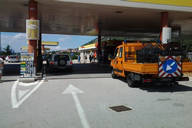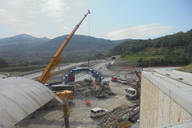
The LIFE SILENT project aims to develop sustainable and eco-friendly solutions for mitigating noise emissions from road and rail traffic in complex urban environments. In these areas, the implementation of sound mitigation measures along propagation paths, such as noise barriers, is impractical due to space constraints and other factors like visual impact and air circulation.
Throughout the project, low-noise pavements made from recycled, non-toxic materials, such as cardboard and end-of-life tyres, will be developed and tested. Similarly, low noise barriers, built using recycled materials and innovative technologies, will be designed to reduce noise emissions from railway traffic.
The project has 3 main objectives:
 |
1 - Enhance the durability of low noise pavements to reduce costs. This goal will be pursued by adding functionalized cellulose fibers from waste materials (e.g., textiles and packaging) and rubber powder from end-of-life tires to bitumen. This is estimated to achieve a 20% increase in durability and a 14% cost reduction. |
|
|
2 - Improve the acoustic, structural, and safety performance of low height noise barriers (LHNB), through the development of an innovative solution. The LHNB will be made of recycled rubber, using metamaterial technology. This technology allows for high acoustic absorption performance without using fibrous materials, which are known to be poorly durable. |
 |
3 - Define procedures for managing and implementing noise mitigation measures in complex environmental scenarios. An operational methodology will be developed and tested to assist infrastructure managers in coordinating and integrating planned sound mitigation actions to achieve optimal results in terms of effectiveness and efficiency. |
 Pilot site
Pilot site
The solutions developed will be tested and implemented at a real test site, located in a densely populated area, known as Muratella, in Rome, Italy, with a population of 154.974 inhabitants. This area is crossed by the Rome-Fiumicino Airport railway line, managed by RFI, and a Motorway, the A91, managed by Anas.
Administrative information
Coordinator: Anas S.p.A
Partners: RFI, ITALFERR, Consiglio Nazionale delle Ricerche (National Research Council), ARPAT - Agenzia Regionale per la protezione dell’ambiente Toscana (Tuscany’s regional agency for environmental protection) , Università degli studi di Bologna (University of Bologna), Università degli studi di Reggio Calabria (University of Reggio Calabria), MOPI - Società italiana per la ricerca applicata e lo sviluppo di nuovi materiali (MOPI, a company specialized in applied research and the development of new materials), Consorzio TEBAID - Consorzio dell’Università di Cosenza per le tecnologie biomediche avanzate (University of Cosenza’s Consortium for advanced biomedical technologies).
Budget: 2.65 Mln €
Co-funded by the European Union: 60%
|
Useful links |
|
|
|
|
| News | |
|
|
| Events | |
 |
LIFE networking event: Solutions for Low Noise Road Surfaces (6 February 2024) 50° Convegno Nazionale AIA Taormina 29-31 maggio 2024
|











